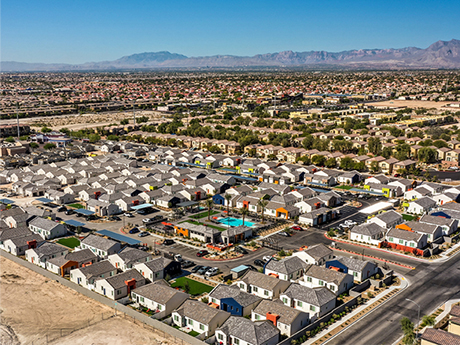— By Mike Ballard, Partner, Ascent Multifamily Accounting in Las Vegas —
Las Vegas — known for its vibrant entertainment scene and thriving real estate market — is experiencing the early signs of a recession. With one of the most substantial construction forecasts in the nation, the Las Vegas multifamily real estate sector is poised to witness a surge in supply with 8,000 units to come online by 2025, according to Avison Young.
However, despite the anticipated surge in deliveries, the Las Vegas market has seen fewer construction starts this year. We can anticipate that the Valley will once again have a shortage of rental housing in 2025 and 2026, which will increase rents and cause concessions to evaporate.
It is also anticipated that up to 10 percent of commercial real estate within the Valley may face foreclosure in the next 18 months. The city is currently experiencing one of the highest rates of foreclosure in the country, with nearly one in every 1,800 homes experiencing foreclosure. This can be attributed to high interest rates and the prospect of a recession forming a dark cloud over the nation’s real estate market.
According to CoStar, quarterly multifamily sales volume has yet to eclipse $150 million in 2023. The surge in supply is also leading to increased vacancies and heightened competition among multifamily property owners. This poses significant challenges for those who may struggle to hold their properties until the market stabilizes.
Flashing Yellow Lights
Adding to the complexity is the predicted recession on the horizon. Despite being more prepared than we were 15 years ago, the combination of escalating vacancies and the economic downturn poses a formidable challenge for multifamily property owners. Real estate owners with bridge loans are particularly poised to experience challenges.
Properties don’t pencil the same as they did three years ago due to:
• Declining values
• Lenders not lending
• Challenging loan terms
• Higher interest rates
Declining values — Investment activity has turned listless due to deteriorating market conditions and rising interest rates. Sales volume in 2023 is on track to be at the lowest point since 2012. Market participants estimate that values have declined by at least 10 percent. This is primarily due to interest rates of 7 percent or higher, with sharper drops in underperforming assets. Cap rates have also likely risen by at least 100 basis points across most Las Vegas multifamily properties.
Lenders not lending — Less than 20 percent of the lenders that were lending two years ago are lending now. Many banks are completely out of the real estate lending business. Debt funds have started to replace some of the banks as lenders on real estate, but not enough are doing so.
Challenging loan terms — The percentage at which a bank would loan on a project is much less. Securing refinancing with lower loan-to-cost percentages is also now the standard. Cash-out refis have transformed into “cash-in” refis, with borrowers required to add additional capital to get the new loan. Real estate borrowers often can’t bring more cash into the deal and, when this happens, they will have to give the property back to the lender. Speaking of lenders, many often require personal guarantees and want to see that borrowers have much more liquidity than they did before.
Higher interest rates — The interest rates on construction loans — that were below 7 percent a few years ago — are now more than 11 percent. Permanent financing that was 3, 4 or 5 percent is now 7, 8 or 9 percent.
The Silver Lining
In this phase of the recessionary cycle, we are presented with more opportunities for local investors to acquire valuable properties at substantial discounts, subsequently holding, enhancing value or selling them when the market rebounds. The most recent and prominent example is the 2008 financial crisis. During this period, many homeowners faced foreclosure, leading to a surge in distressed properties. Investors who had cash on hand were able to purchase these properties at significantly reduced prices. As the market recovered in subsequent years, these investors realized substantial gains by either selling the properties or holding them for rental income.
Successful investors often possess a good understanding of the real estate market cycles and the ability to identify properties with the potential for long-term appreciation. But understanding where we are in the real estate cycle is crucial if you’re looking to navigate the market effectively.
Key indicators of the impending recession include:
• An increase in available properties
• Heightened demand for construction materials
• A slowdown in job growth
• A deceleration in rent growth.
Recent data from CoStar reveals that Las Vegas has experienced a year-over-year rent decrease of 4.7 percent, placing it among the highest rent decreases of all major U.S. metros. As a result, investors who can weather the market downturn will benefit when it recovers…and have the potential for future increases in property values.
While Las Vegas has experienced a number of new real estate and multifamily developments over the past year (and into the coming year), many of these properties are offering discounts to attract renters while maintaining higher asking rents. Still, the people keep coming. Clark County had a population of 2.29 million residents in 2021. This growth trend is forecasted to continue for the next two decades, with projections indicating a population of 2.94 million by 2035 and an estimated 3.39 million residents by 2060.
As Las Vegas has entered the recession phase of the real estate cycle, renters and investors alike are advised to monitor market developments closely and make informed decisions to capitalize on emerging opportunities.


